Elite Direto XR-T smart trainer review
Not as refined as other top end turbos – but significantly cheaper, with reliable power readings
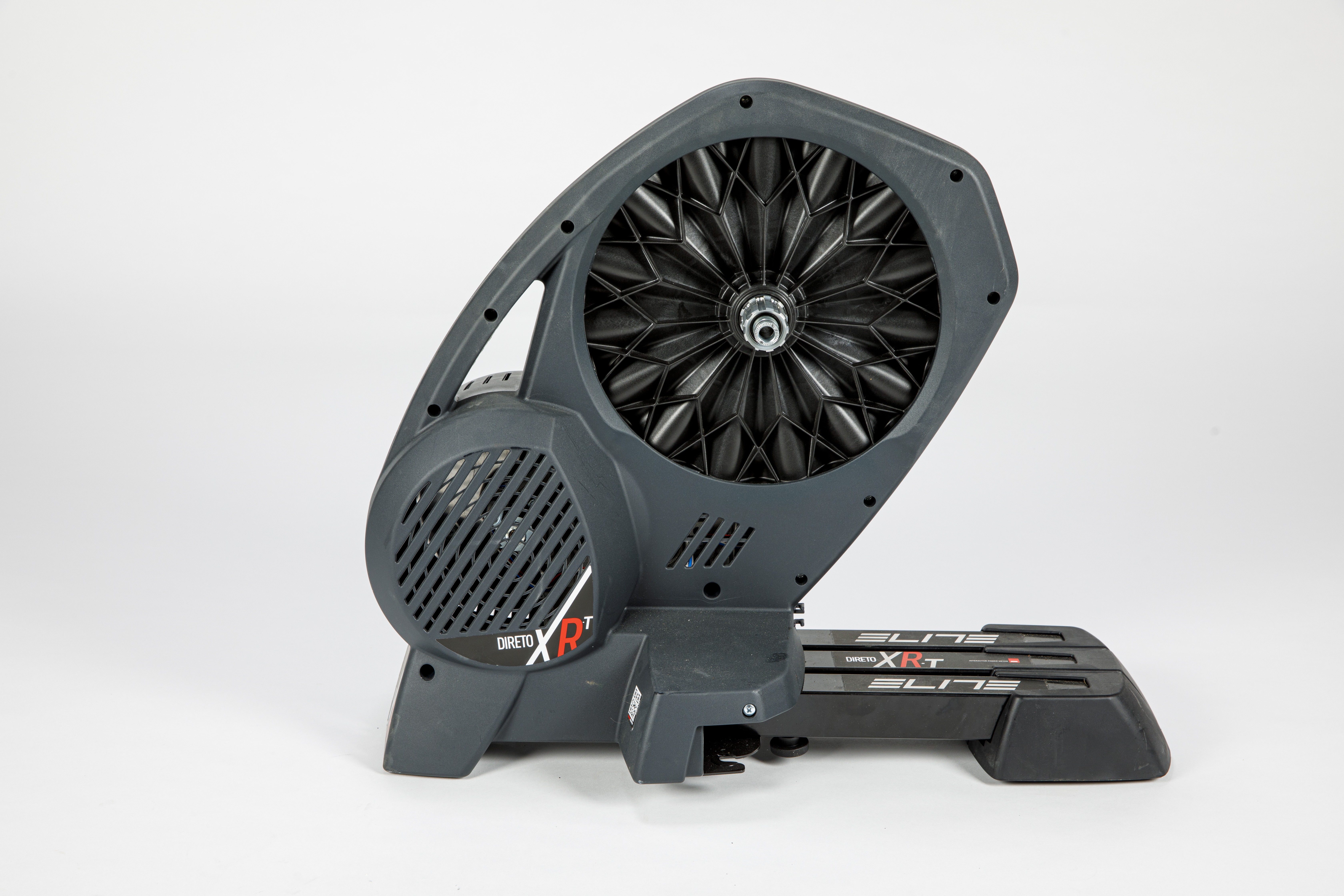
The Direto XR-T has a lot going for it – a fair bit cheaper than other high end turbos, it still delivers quick changes to the resistance on virtual gradients and feels good for sprinting and hard efforts. It’s let down by the erg mode, which feels a bit unrefined and quite a slog at times. For those interested in eRacing, the Direto XR-T takes a very long time for the watts to drop to zero in order to ‘super tuck’. At full price, it’s not really cheap enough to justify these idiosyncrasies, but when on sale – as it often is – the performance is very good for the price.
-
+
Good for sprints and hard efforts
-
+
Quick response to changes in virtual gradients
-
+
Reasonable power accuracy
-
-
It can feel a bit of a struggle not to let your cadence drop in erg mode
-
-
It takes a very long time for the watts to drop to zero, allowing you to ‘super tuck’ in Zwift races
-
-
Manuel calibration
- -
- -
You can trust Cycling Weekly.

First, it helps to get a handle on Elite’s interactive smart trainer hierarchy. The direct drive models start with the Zumo for around £500. Next up is the Suito – which comes with an 11 speed cassette already installed – while the Suito-T, differs only in that it doesn’t come with a cassette.
All the way up the hierarchy, there’s a continual increase in the maximum resistance, maximum simulated gradient and the power accuracy, culminating in the Direto XR (which comes with an 11 speed cassette) and the Direto XR-T which, like the Suito-T, comes without a cassette.
Although top of Elite’s tree, the £829.99 price tag makes the Direto XR-T one of the cheapest range topping turbos out there – Tacx’s Neo 2T comes in at £1,199, while Wahoo’s KICKR V5 sits at £999.
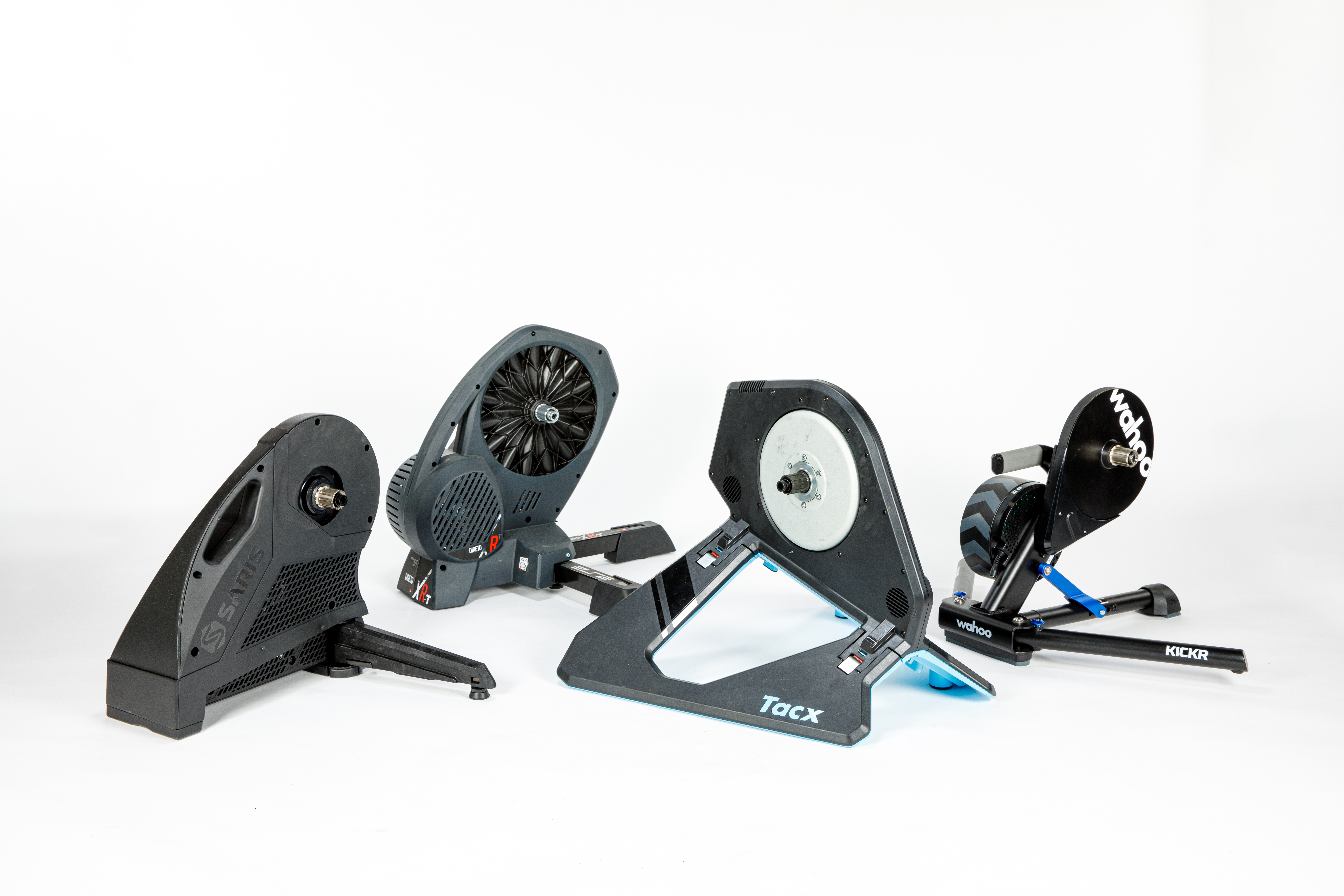
We tested the Saris H3 as part of a four-up comparison grouptest to find the best smart turbo trainer, the Elite Direto XR-T went up alongside the Saris H3, the Wahoo Kickr V5 and Tacx Neo 2T.
So, with the context now out of the way, let’s drill into just what the Direto XR-T has to offer.
Elite Direto XR-T specs

There are three spec points which brands love to band about.
The first is the maximum resistance and with the Direto XR-T claiming 3,600w, it does have an empathic claim to this particular top trump. But it is worth noting that even the very best amateur track sprinters don’t tend to go much higher than 2,000w, so you’re not really going to be gaining anything from this trainer’s extra capacity.
With a maximum gradient of 24%, the Direto XR-T also exceeds the steepest roads currently present on Zwift (the second climb of the Cobbled Climbs Reverse course in the Richmond world ramps up to 22%, although only for a split second).
A claimed power accuracy of ±1.5% isn’t, of course, equal to the ±1% some other brands claim. But even then, it’s not at all uncommon for two power meters both claiming ±1% accuracy to spit out two sets of readings which fall outside of each other’s ranges – so make of that what you will.
Although these three elements are important – particularly so in mid range and entry level turbos – it’s really the ride feel and any other unique selling points which mark the most significant differences between the top end turbos.
Elite Direto XR-T compatibility and setup
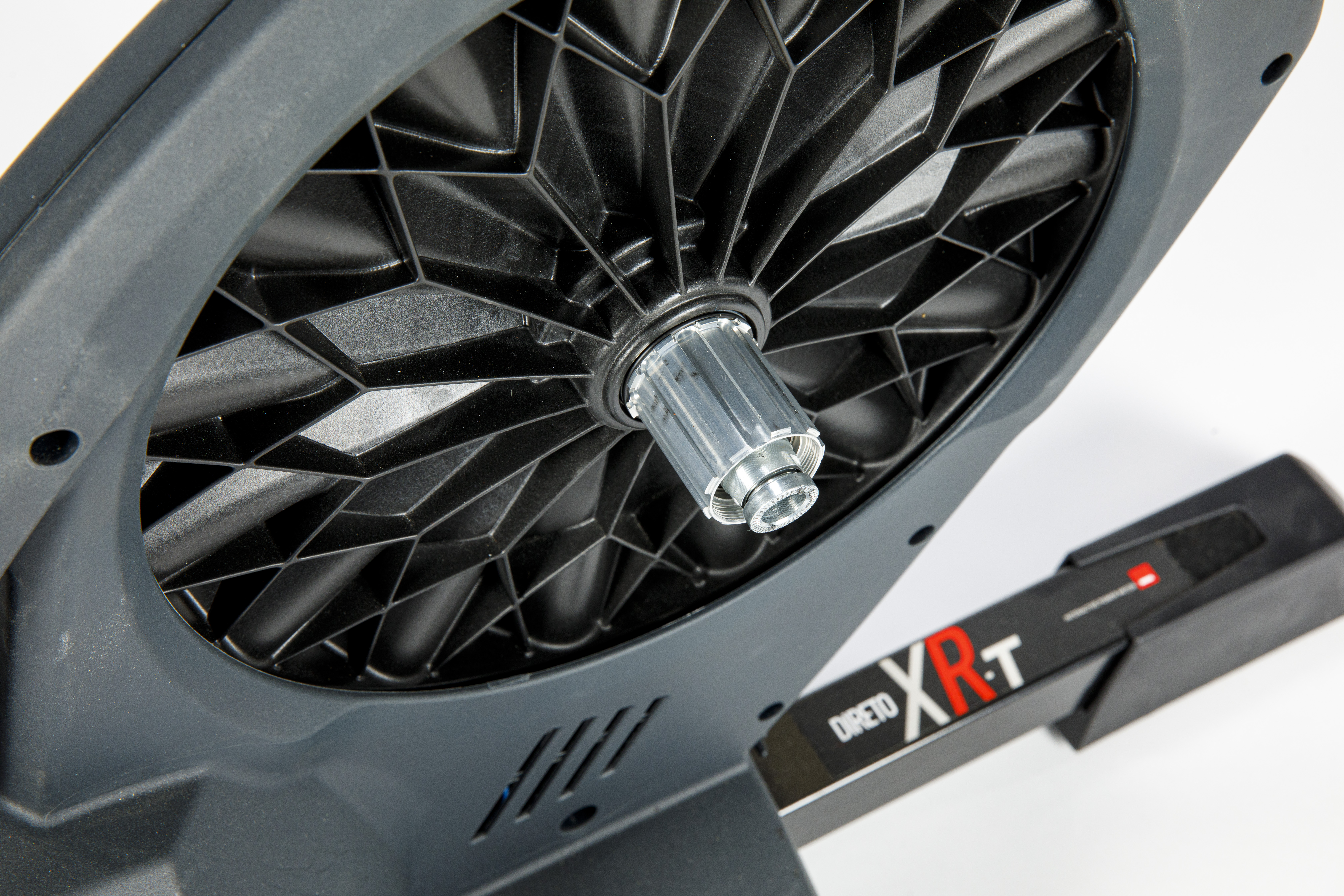
The Direto XR-T ranks well for compatibility, it comes out the box with a Shimano HG11 freehub body, adaptors for 130mm and 135mm QR axles and 142x12mm through axles too – which will cover the majority of people.
Freehubs for Campagnolo, SRAM XDR and Shimano Microspline are also available, if you’re running any of those systems. Adaptors for 148x12mm Boost hubs and 157x12mm Super Boost hubs are available too. If you’re still running 135x10mm or 135x12mm thru axles, Elite has you covered too.
Setting up out of the box is pretty easy, simply spread out the legs and tighten the screws, put on your cassette and adapters, then plug it in and you’re ready to connect. To ensure accurate power readings, you’ll also need to warm up the turbo by riding for 10 minutes and then perform a spin down ‘calibration’ or zero offset.
It’s not a super heavy turbo, but the position of the handle is a little more awkward to hold than the Wahoo Kickr, for instance.
Folding the Direto away is quite quick and the shape it makes means it’s relatively easy to pack away - however the footprint remains a little larger than some other turbo trainers.
Elite Direto XR-T ride
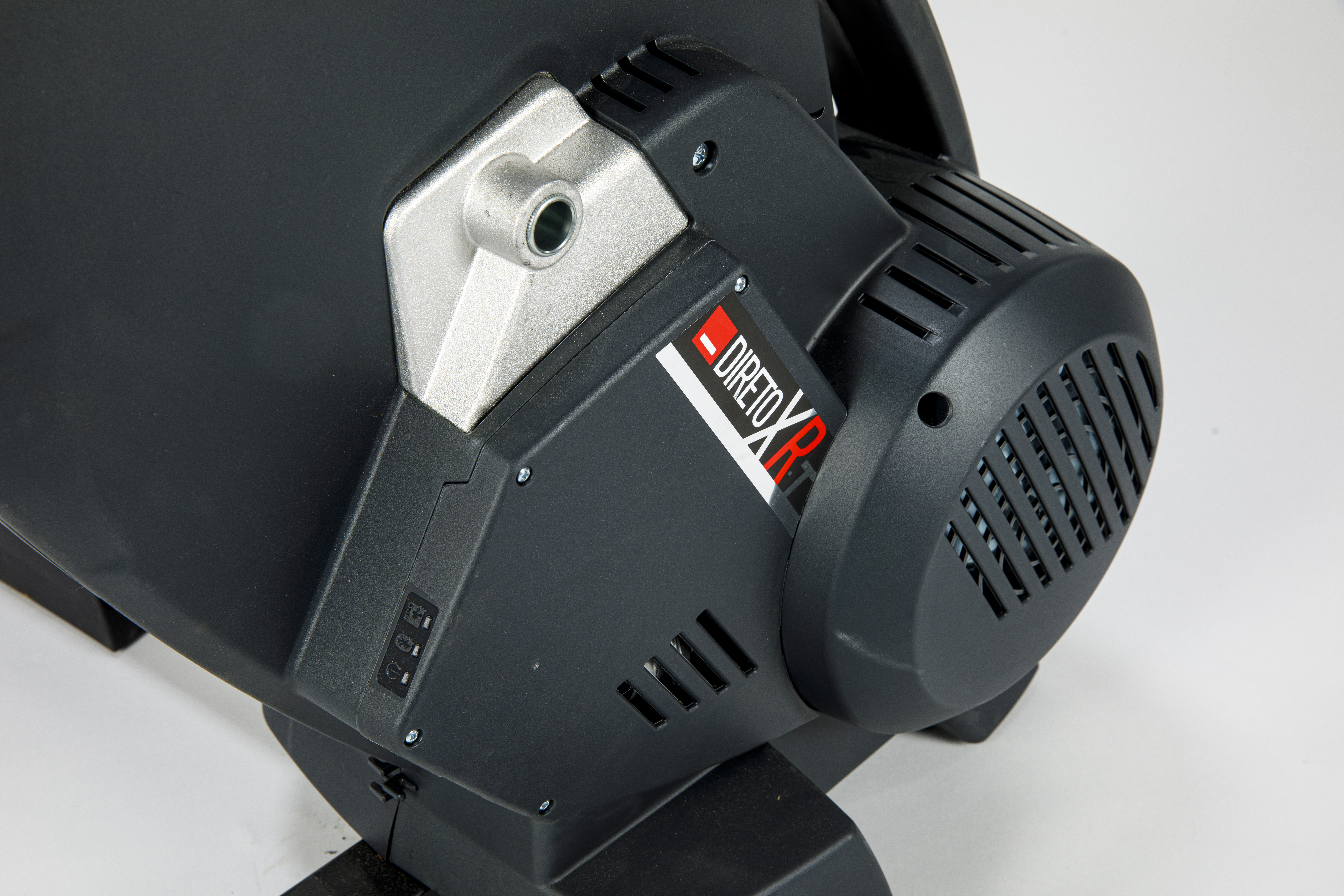
Just like with a bike, it’s when you’re really putting the hammer down that you gain the best sense of a turbo’s mettle. In terms of stability, the Elite Direto XR-T performs better than its relatively light weight would suggest – there is still some movement when putting in an all-out effort, but the wide legs mean it isn’t unacceptable.
In terms of how the resistance ramps up for sprinting, the Direto doesn’t really mimic the feeling of a bike on the open road – no very hard initial effort and then having to shift through many gears quickly as you get up to speed. The Direto XR-T has a much more linear feel – and that's really a perk, fewer gear shifts means less chance of a misshift. It might not simulate reality so much, but it’s a nicer user experience.
The erg mode, on the other hand, was a bit of a disappointment. Turning this on can help you keep to your set session; if you’re supposed to be holding 250w it’ll keep you there by reducing the resistance if you start pedalling too fast or ramping it up if you start pedalling too slow.
But with the Direto XR-T, it felt like a constant struggle to keep my cadence at a comfortable level. A slight drop in my RPM and it would immediately pile on more resistance, which would begin a vicious cycle of another drop in my cadence and progressively more resistance.
Of course, more resistance when pedalling a lower RPM is half the point of erg mode, but the Direto XR-T felt a little too keen to add this on compared to other turbos.
The same tendencies showed through when doing some 30 seconds on / 30 seconds off efforts – I needed to really spin up a high cadence before the 400w interval started or else it’d feel like hitting a brick wall of huge resistance which would make just turning the pedals a struggle.
On the other hand, this ability to ramp up the resistance super high, super quickly made it a really good match for riding around the virtual roads of Zwift, whether that’s the rolling sections of Titan’s Grove or the super steep ramps on Richmond’s Cobbled Climbs Reverse.
Power analysis
I hooked up the turbo with a Merida Scultura sporting the new Dura Ace power meter crankset and a pair of Garmin Vector 3 pedals (don’t worry, these are the updated version which fixed the reliability issues of the original pedals).
The efforts I did were a 10 minutes steady, using erg mode to keep the turbo power at 250w, to see what sort of numbers the turbo puts out in the lower power bands and over a longer period of time. I also did five sets of 30s on and 30s easy to see how quickly the turbo would respond to the efforts and whether the numbers would do anything different at around 400w.
After that, I did a couple of sprints to see again how the numbers compare at a higher end effort and, finally, I did a few sets of 10 seconds on and 10 seconds completely off to see how the turbo fairs at dropping down to zero watts for that ‘super tuck’ in Zwift racing.
For the 10 minute effort the results were:
| Elite Direto XR-T | 246w |
| Shimano Dura-Ace power cranks | 247w |
| Garmin Vector 3 power pedals | 242w |
Which is pretty impressive for how closely the numbers all line up - although slightly disappointing that the Direto read four watts lower than the 250w it was set to with erg mode.
For the 30s on / 30s easy, the numbers came out as this:
| Row 0 - Cell 0 | Effort 1 | Effort 2 | Effort 3 | Effort 4 | Effort 5 |
| Elite Direto XR-T | 390w | 389w | 379w | 381w | 384w |
| Shimano Dura-Ace power cranks | 392w | 391w | 379w | 379w | 370w |
| Garmin Vector 3 power pedals | 385w | 383w | 373w | 369w | 374w |
Again, the Elite Direto under pitched the efforts, but was still impressively consistent against the other power meters. Now, this really was a surprise, as when I was doing the effort the numbers were spiking and dropping all over the place, within a band as wide as about 80 watts.
The resistance felt consistent the whole time, if my eyes were closed I would have had no complaints – and looking at the averages, it seems to have all sorted itself all out – but those spikes were quite disconcerting when doing the efforts.
For the sprints the numbers were:
| Row 0 - Cell 0 | 1 sec | 5 sec |
| Elite Direto XR-T | 1,149w | 1,089w |
| Shimano Dura-Ace power cranks | 1,135w | 1.084w |
| Garmin Vector 3 power pedals | 1,178w | 1,091w |
Interestingly, the Dura-Ace power meter and the Garmin Vector pedals switched places from the 250w effort regarding which one was reading highest. Now, all power meters read slightly differently (there's some explanation of why this is here) – and there’s only so much you can conclude from taking what’s essentially a sample size of one from each brand and pitting them against each other.
But it is at least reassuring to see that the Direto XR-T is comfortably what the other two power meters reported – to be way out would have been grounds for some raised eyebrows at the very least.
Finally, with the dropping to zero watts, the Garmin pedals were quickest, generally taking just one or two seconds. Shimano’s power cranks were consistently around the four second mark – which would be frustrating, but not the end of the world, in a Zwift race.
The Elite Direto XR-T, though, would still be reading around 10 watts at the end of the 10 seconds. On the final effort when I stopped pedalling and stayed stopped, it was around 15 seconds until the Elite finally read zero.
Of course, not an issue if you’re not eRacing, but really quite infuriating if you are.
Elite Direto XR-T value
In terms of value, the Elite Direto XR-T is significantly cheaper than the top end turbos of Wahoo and Tacx ($1,199.99 / £999.99 and $1,399.99 / £1,199.00, respectively). However, at a still significant $949.99 / £829.99, it’s not that much cheaper than the Saris H3 at $1,099.99 / £899.99.
If you’re not a heavy user of erg mode and aren’t interested in Zwift racing, then you might as well save a bit of money and go for the Elite Direto XR-T – for everything other than those two aspects it’s really quite good - and the power numbers proved to be very reliable.
However, if erg mode and Zwift racing constitute a major part of how you’ll be using the turbo, then you would be much better off spending a bit more on a turbo which does those things better.
Elite Direto XR-T conclusion
Overall, the Elite Direto XR-T is a good turbo trainer, with consistent power readings, quick adjustments to virtual gradients and a good feel for sprints and hard efforts. It’s also a little cheaper than the comparable top end offerings from Wahoo, Tacx and Saris.
However, the erg mode does slam on like a brick wall and has a greater tendency to send you into a death spiral of ever lower cadence than other trainers do. The very long time it takes for the trainer to register zero watts once you’ve stopped pedalling means that it can be quite frustrating when trying to assume a ‘super tuck’ when racing downhill on Zwift too.
But if those two aspects aren’t a concern for you – or if you’ve been able to find it on a significant discount – then you won't be disappointed.

Thank you for reading 20 articles this month* Join now for unlimited access
Enjoy your first month for just £1 / $1 / €1
*Read 5 free articles per month without a subscription

Join now for unlimited access
Try first month for just £1 / $1 / €1
Get The Leadout Newsletter
The latest race content, interviews, features, reviews and expert buying guides, direct to your inbox!

After winning the 2019 National Single-Speed Cross-Country Mountain Biking Championships and claiming the plushie unicorn (true story), Stefan swapped the flat-bars for drop-bars and has never looked back.
Since then, he’s earnt his 2ⁿᵈ cat racing licence in his first season racing as a third, completed the South Downs Double in under 20 hours and Everested in under 12.
But his favourite rides are multiday bikepacking trips, with all the huge amount of cycling tech and long days spent exploring new roads and trails - as well as histories and cultures. Most recently, he’s spent two weeks riding from Budapest into the mountains of Slovakia.
Height: 177cm
Weight: 67–69kg
-
 'This race is absolutely disgusting': Peloton reacts to another brutal Paris-Roubaix Femmes
'This race is absolutely disgusting': Peloton reacts to another brutal Paris-Roubaix FemmesNow in its fifth edition, Paris-Roubaix Femmes is still a tough race, even for the best bike riders in the world
By Adam Becket Published
-
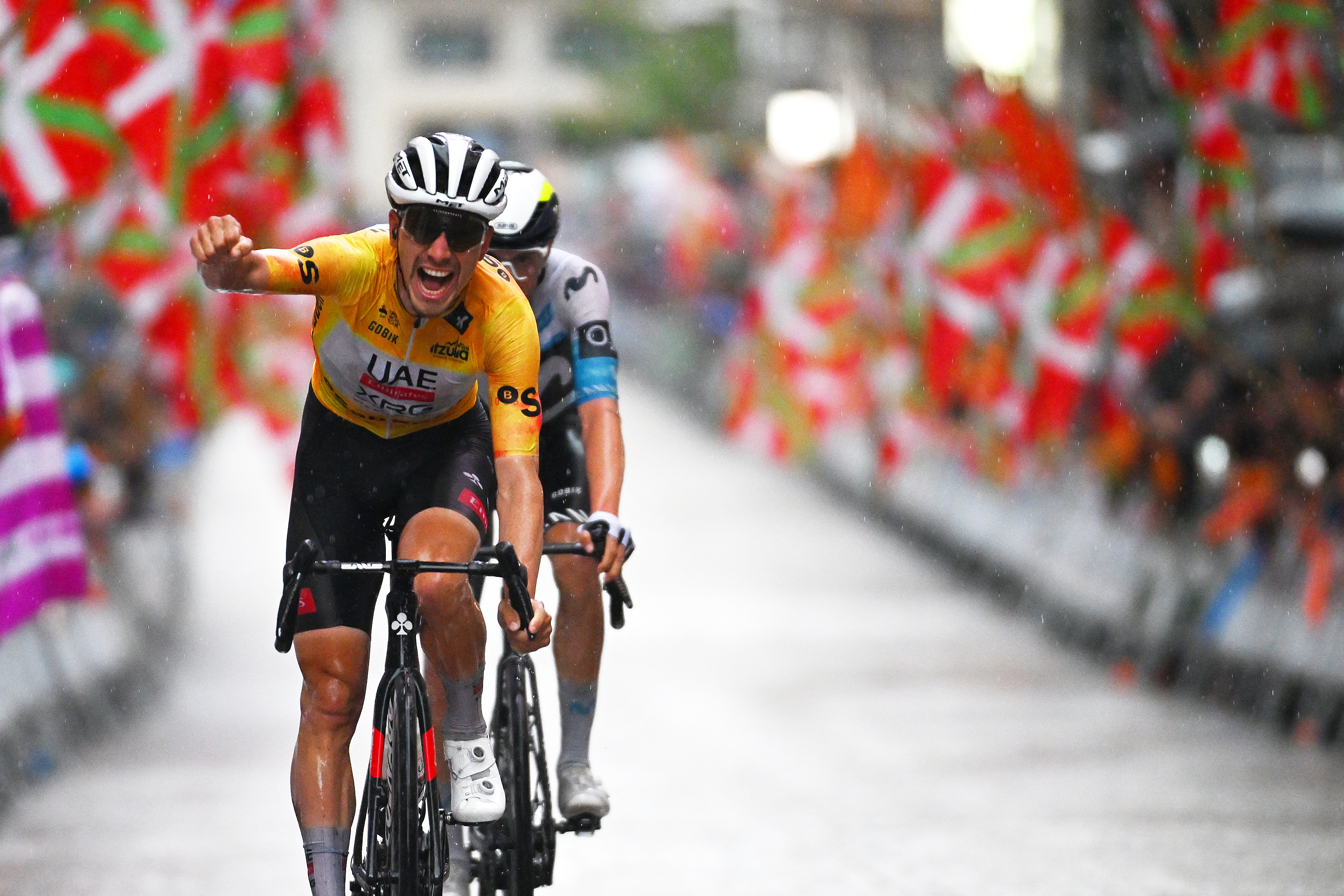 ‘It’s the biggest win of my career’ says João Almeida after crushing Itzulia Basque Country success
‘It’s the biggest win of my career’ says João Almeida after crushing Itzulia Basque Country successUAE rider wins the final stage to finish almost two minutes clear of Enric Mas on GC, with Max Schachmann in third
By Peter Cossins Published
-
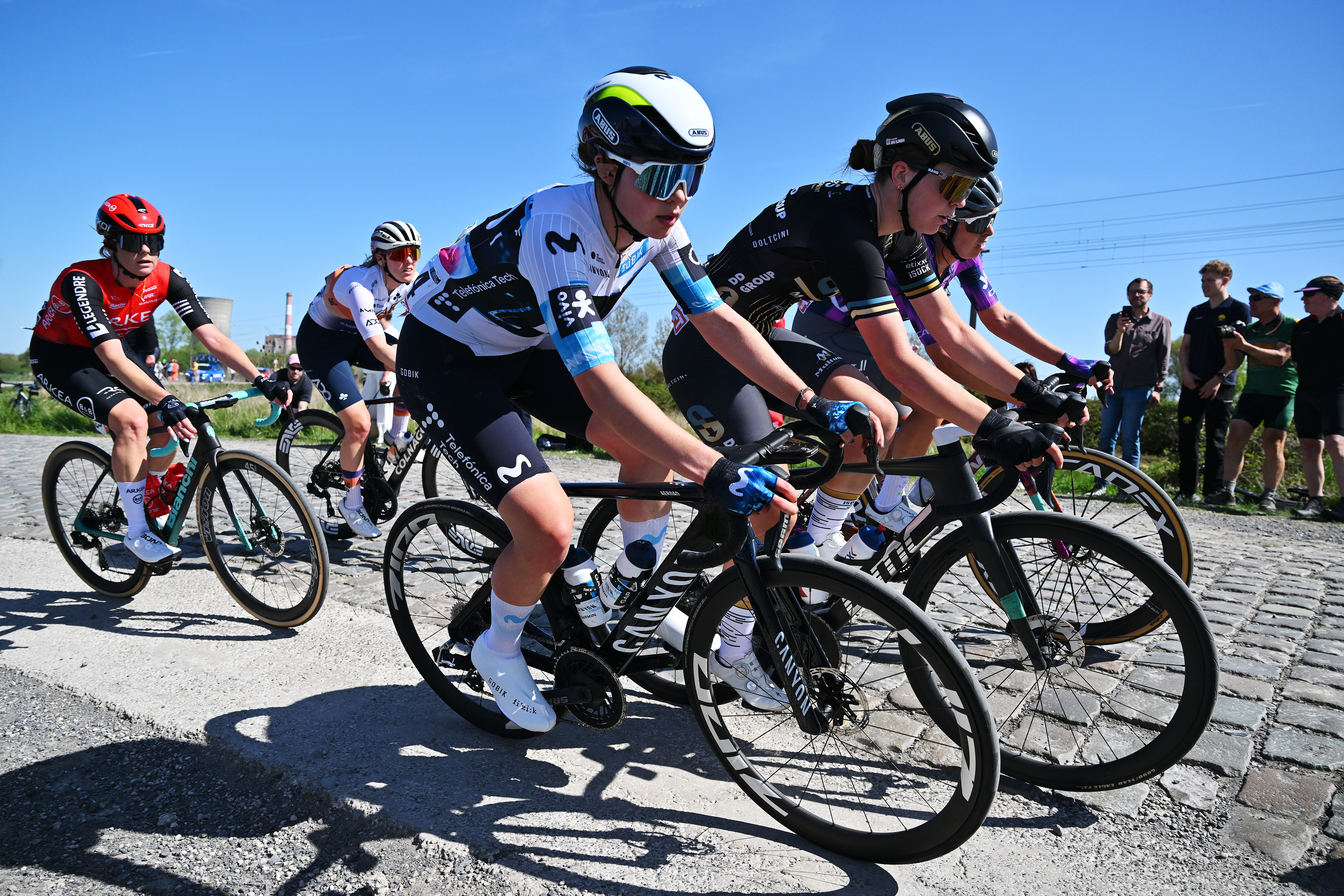 'I have an exam in a month and a half' - Carys Lloyd becomes Paris-Roubaix's youngest ever rider
'I have an exam in a month and a half' - Carys Lloyd becomes Paris-Roubaix's youngest ever riderBritish teenager and A-Level student makes it to the velodrome on debut
By Tom Davidson Published